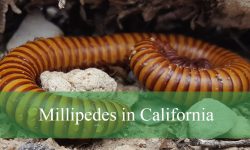If you’re a bird enthusiast or just curious about wildlife, learning about the diverse ducks in Arkansas is an exciting adventure. Arkansas’s varied wetlands, rivers, and lakes provide perfect habitats for many duck species throughout the year. Whether you’re exploring during migration or winter months, the state offers excellent opportunities to spot and identify a wide range of ducks.
The ducks in Arkansas range from common visitors like the Mallard to rare and colorful species like the Wood Duck and Canvasback. Each species has unique features, behaviors, and habitats that make birdwatching in Arkansas both rewarding and educational. This guide will help you recognize and appreciate the 33 most notable types of ducks you can find across the state.
By familiarizing yourself with these ducks in Arkansas, you’ll enhance your outdoor experience and contribute to local conservation efforts. This article includes pictures and detailed identification tips to help both beginners and seasoned birders spot and learn about these fascinating waterfowl.
Most Common Ducks in Arkansas (Very Frequently Seen)
Mallard (Anas platyrhynchos)
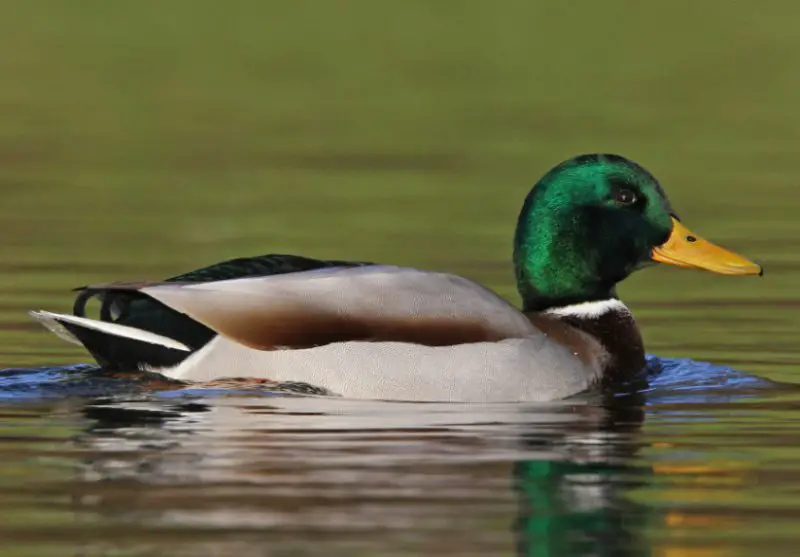
Mallards are among the most recognizable and widespread ducks in North America. The male, or drake, displays a glossy green head, a white neck ring, chestnut-brown chest, and gray body. Females are mottled brown with an orange bill marked by dark patches. Both sexes have a distinctive blue speculum edged in white on their wings, visible in flight or when resting.
These dabbling ducks are commonly found in Arkansas wetlands, lakes, rivers, and flooded agricultural fields, especially during winter migration. They prefer shallow water where they can easily tip forward to forage. Mallards are known for their adaptability and can even be found in city parks and suburban ponds.
Mallards feed mainly on aquatic vegetation, seeds, and small invertebrates. They will also graze on grain in agricultural fields, especially rice and corn. In Arkansas, large concentrations gather in the Mississippi Alluvial Valley, where they make up the majority of wintering waterfowl during aerial surveys.
Gadwall (Mareca strepera)
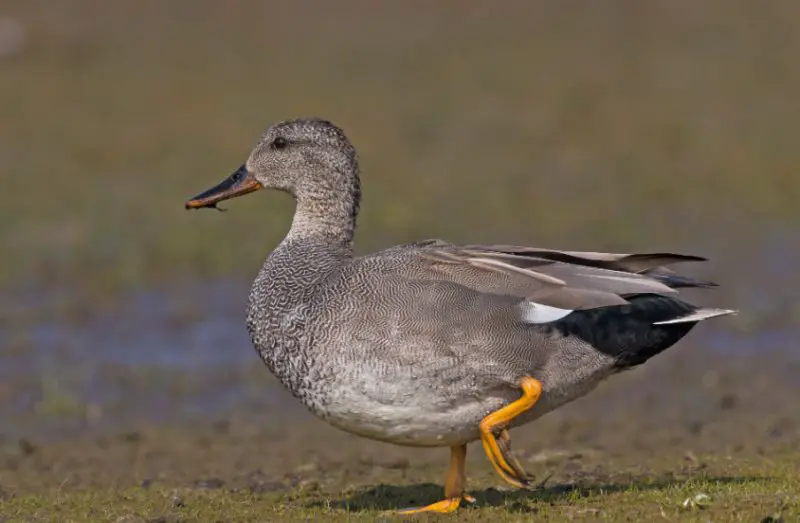
Gadwalls are medium-sized ducks with more subdued coloring than other species. Males appear gray with a black rump and white wing patches that are most noticeable in flight. Females are brown with a thinner, slightly orange-edged bill. Unlike more vividly colored ducks, gadwalls rely on subtle contrasts and patterns for camouflage.
In Arkansas, gadwalls are one of the most frequently seen dabbling ducks during fall and winter. They frequent flooded fields, shallow wetlands, and forested swamps, especially in regions like the Cache River and White River National Wildlife Refuges. They are social birds and often gather in mixed flocks with other waterfowl.
Gadwalls primarily consume aquatic plants, including pondweed, algae, and grasses. They also eat small insects, snails, and crustaceans. Their feeding behavior is often calm and methodical, as they dabble and upend to reach vegetation below the water’s surface.
Green-winged Teal (Anas crecca)
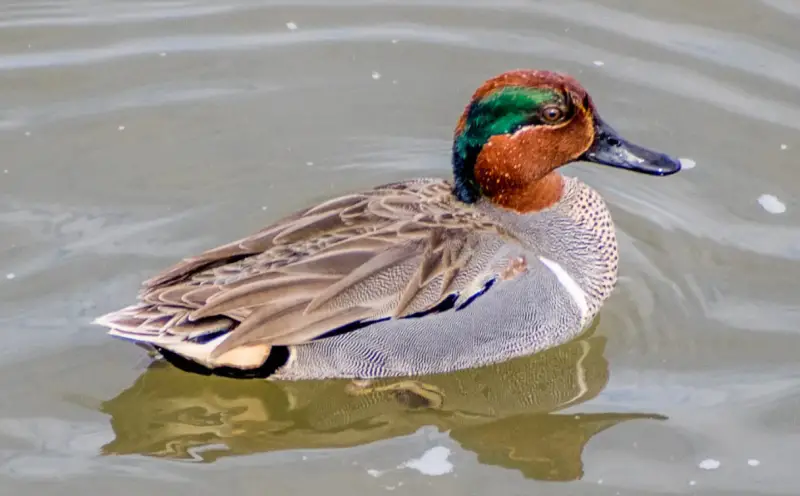
The Green-winged Teal is the smallest dabbling duck in North America. Males are striking with a chestnut head, iridescent green eye patch, and gray body with a vertical white stripe near the breast. Females are mottled brown and resemble small female mallards, but both sexes feature a bright green wing patch that stands out during flight.
This species is abundant in Arkansas during migration and winter months, commonly inhabiting flooded fields, shallow ponds, and wetlands. Green-winged Teals are fast, agile fliers and often flush in tight, compact flocks when disturbed. Their small size makes them one of the earliest ducks to migrate in the fall and spring.
They feed primarily on seeds and aquatic vegetation but will also consume insects and crustaceans during the breeding season. In Arkansas, they favor moist-soil units and wetland edges where food is plentiful and shallow water allows easy foraging.
Northern Pintail (Anas acuta)
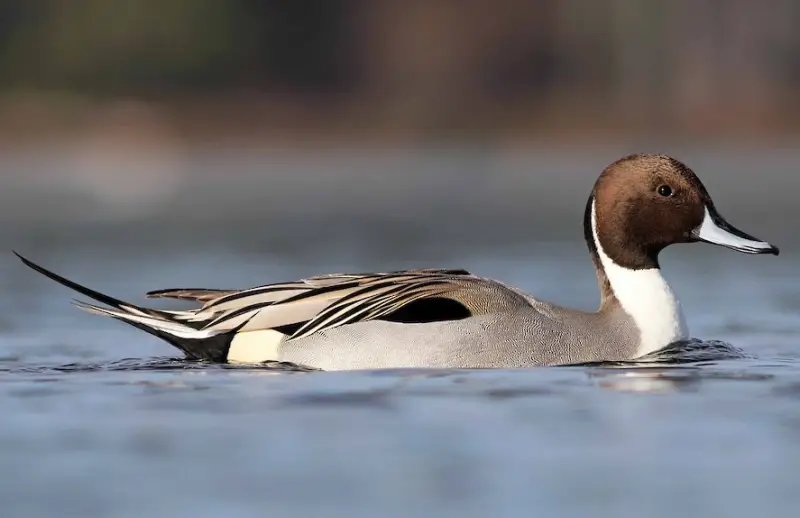
The Northern Pintail is a graceful and slender duck with a long neck and sharply pointed tail feathers. Males feature a chocolate-brown head, white neck, grayish body, and elongated central tail feathers. Females are mottled brown with a more slender profile than similar species. Both sexes have a pale blue-gray bill and long wings.
In Arkansas, pintails are among the earliest migrants and are especially numerous in rice fields, wet prairies, and shallow marshes. They favor open wetlands and agricultural landscapes and can gather in large numbers during winter, particularly in the Mississippi Delta region.
Pintails feed on seeds, grains, and aquatic plants, often gleaning from flooded crop fields like rice. They are agile fliers and may travel great distances between feeding and roosting sites. Their elegant appearance and early arrival make them a favorite among birdwatchers and waterfowl enthusiasts in the state.
Northern Shoveler (Anas clypeata)
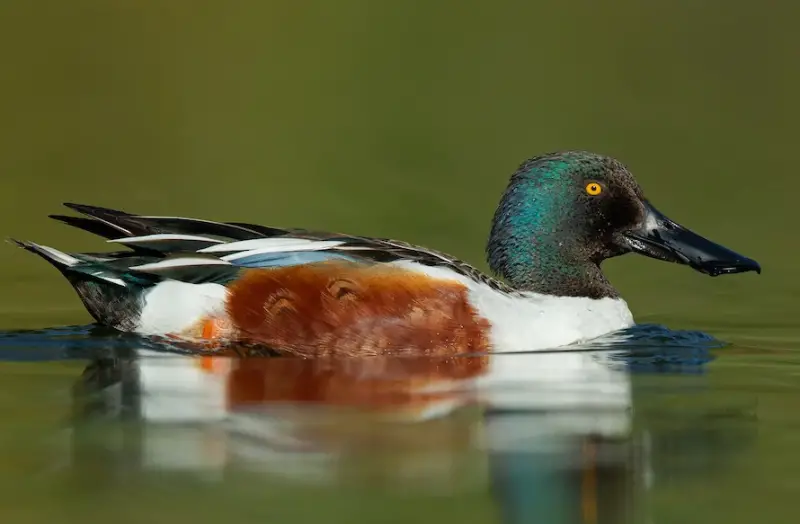
Northern Shovelers are instantly recognizable thanks to their oversized, spoon-shaped bills. Males have an iridescent green head, white chest, and chestnut sides, while females are mottled brown with an orange bill. The wide, flattened bill helps them filter food from the water, making them unique among dabbling ducks.
In Arkansas, shovelers are common migrants and winter residents, particularly in managed wetlands, flooded fields, and shallow lakes. They often swim in circles with other shovelers to stir up food, forming tight feeding flocks. Their distinctive head shape and behavior make them easy to spot even among mixed flocks.
They feed by skimming the surface or filtering small aquatic organisms, seeds, and invertebrates through their specialized bills. Northern Shovelers thrive in habitats with dense vegetation and muddy bottoms, where they can use their feeding adaptations to maximum advantage.
Wood Duck (Aix sponsa)
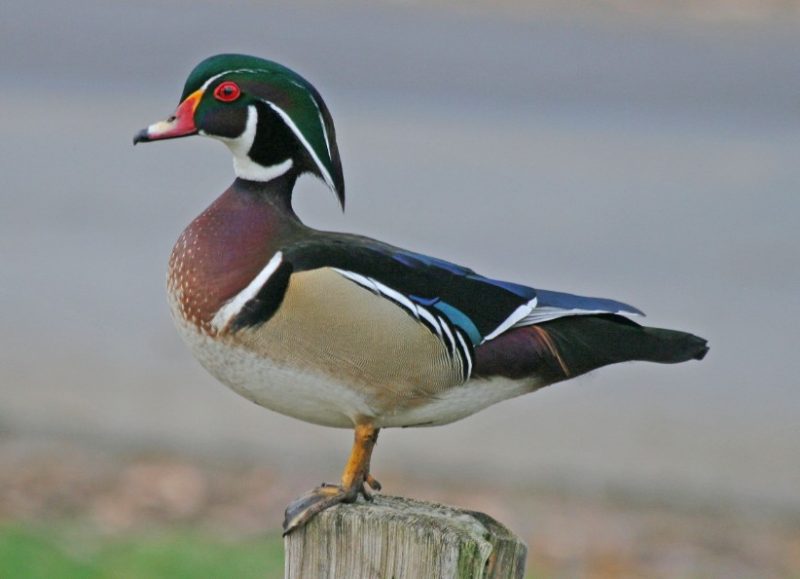
Wood Ducks are among the most colorful and striking waterfowl in North America. The male displays iridescent green and purple plumage with bold white stripes on the face and neck, red eyes, and a bright red bill with black markings. Females are more muted, with gray-brown bodies, white eye rings, and a distinctive crest on the head. Both sexes have distinctive crests and short tails.
In Arkansas, Wood Ducks prefer wooded swamps, flooded forests, and river edges where they nest in tree cavities. They are often seen perching in trees near water and are one of the few duck species that nest in natural tree holes or nest boxes. Wood Ducks breed in spring and summer but are present year-round in parts of the state.
Their diet consists mostly of acorns, seeds, and aquatic plants, supplemented by insects and other invertebrates. Wood Ducks forage by dabbling or tipping in shallow water and occasionally by foraging on land. Their preference for forested wetlands makes them a vital part of Arkansas’s diverse wetland ecosystems.
American Wigeon (Mareca americana)
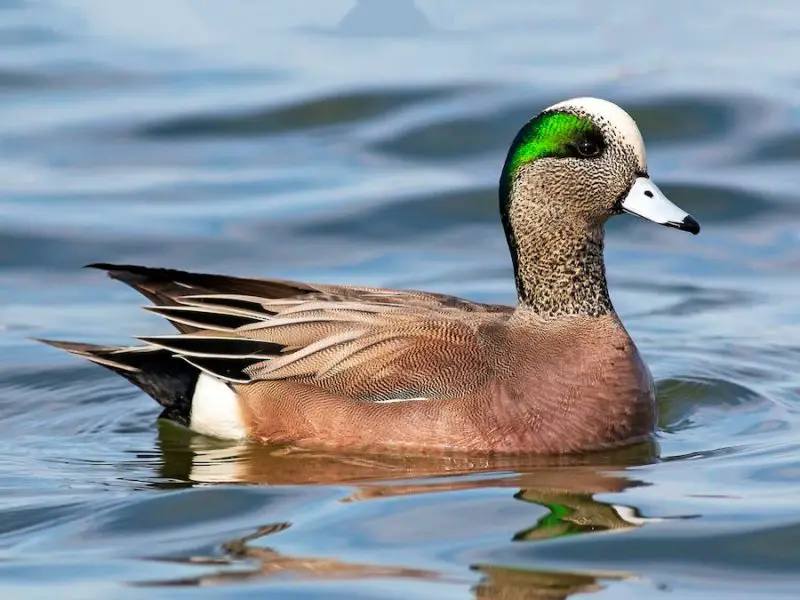
The American Wigeon is a medium-sized dabbling duck known for its distinctive round head and short neck. Males have a white forehead and crown, green patch extending from the eye, and a pinkish bill with a black tip. Females are mottled brown with a pale blue-gray bill. Both sexes show a white patch on the wing, visible in flight.
In Arkansas, American Wigeons frequent shallow freshwater wetlands, flooded fields, and marshes during migration and winter. They often feed alongside other dabbling ducks but are easily identified by their unique vocalizations and head shape. Wigeons are social birds, often forming large flocks.
Their diet primarily consists of aquatic vegetation, grasses, and algae. Unlike many dabblers, American Wigeons also graze on land, feeding on grasses and grains in agricultural fields. This versatile diet helps them thrive in Arkansas’s mixed wetland and farmland habitats.
Blue-winged Teal (Spatula discors)
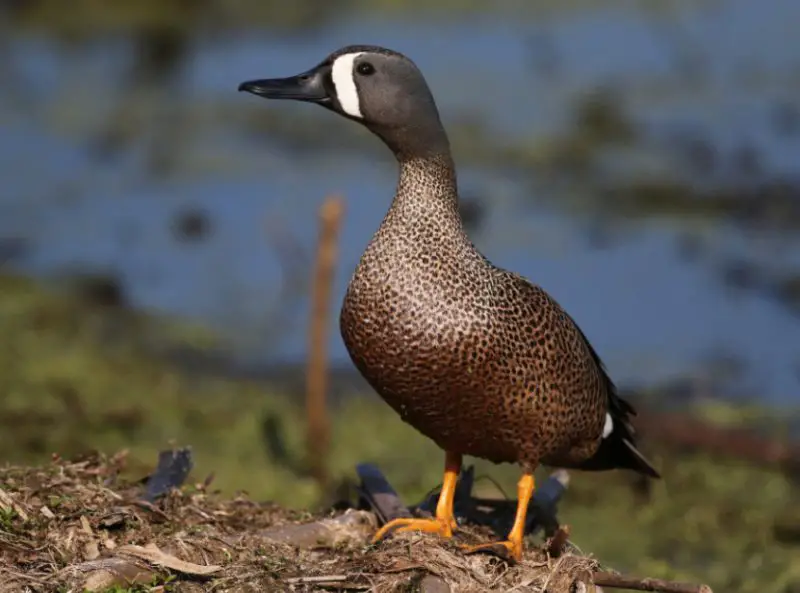
Blue-winged Teals are small, fast-moving ducks known for the striking blue patches on their wings visible during flight. Males have a slate-gray head with a white crescent in front of the eye and a mottled gray-brown body. Females are mottled brown and less conspicuous but also show the blue wing patches.
In Arkansas, Blue-winged Teals are common during spring and fall migrations and winter in shallow wetlands, flooded fields, and ponds. They prefer open areas with emergent vegetation and are one of the earliest ducks to arrive during migration seasons. They often form loose flocks with other dabblers.
Their diet consists mainly of seeds and aquatic plants but also includes insects and crustaceans, especially during breeding. Blue-winged Teals forage by dabbling in shallow water and sometimes by grazing on moist soil. Their preference for diverse wetlands makes them a key species in Arkansas’s waterfowl populations.
Lesser Scaup (Aythya affinis)
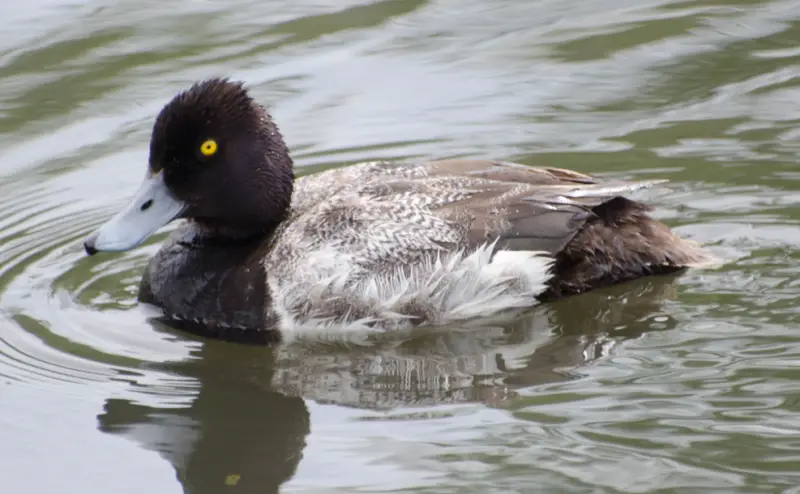
Lesser Scaups are medium-sized diving ducks with rounded heads and distinctive blue-gray bills. Males have glossy black heads with purple iridescence, white flanks, and gray backs. Females are brown with a white patch near the base of the bill and a duller appearance overall. Both sexes show a pale blue bill that is diagnostic.
In Arkansas, Lesser Scaups are most common during migration and winter, frequenting lakes, reservoirs, and deep marshes. They prefer open water habitats with abundant submerged vegetation. These ducks often dive for food and may form large flocks on deeper waters.
Their diet consists primarily of aquatic invertebrates like mollusks, crustaceans, and insect larvae, along with seeds from submerged plants. Lesser Scaups feed by diving underwater, often diving repeatedly in quick succession to find food. Their diving behavior contrasts with many dabbling species found in the state.
Ring-necked Duck (Aythya collaris)
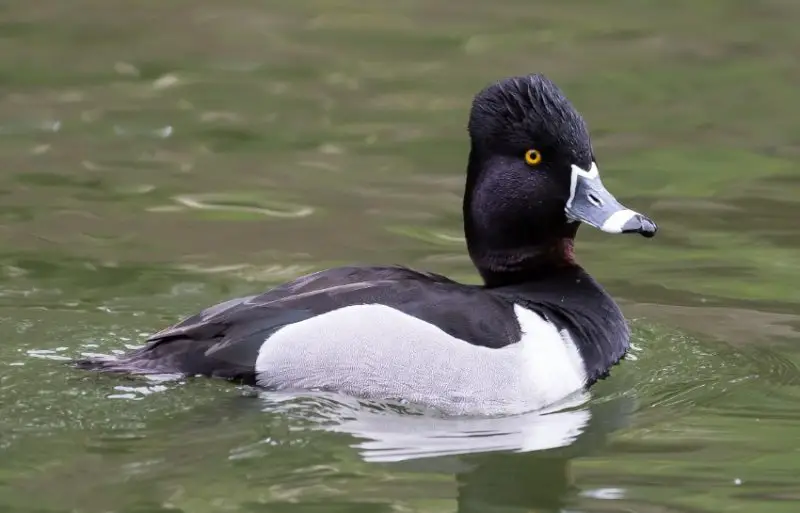
The Ring-necked Duck is a medium-sized diving duck known for its peaked head and striking black-and-white markings. Males have a glossy black head, chest, and back with white sides and a distinctive chestnut ring around the neck, which is often hard to see. Females are mottled brown with a white eye ring and grayish bill with a white ring near the tip.
In Arkansas, Ring-necked Ducks are common migrants and winter residents in freshwater lakes, ponds, and slow rivers. They prefer habitats with ample submerged vegetation and often form flocks with other diving ducks. Their pointed heads and compact size help distinguish them from similar species.
Ring-necked Ducks feed by diving for seeds, aquatic plants, and invertebrates. They often forage in shallow to moderate-depth water and are known to tip forward like dabblers to reach food. Their adaptability to various freshwater habitats makes them a regular part of Arkansas’s winter waterfowl community.
Fairly Common Ducks (Seen Regularly During Migration/Winter)
Canvasback (Aythya valisineria)
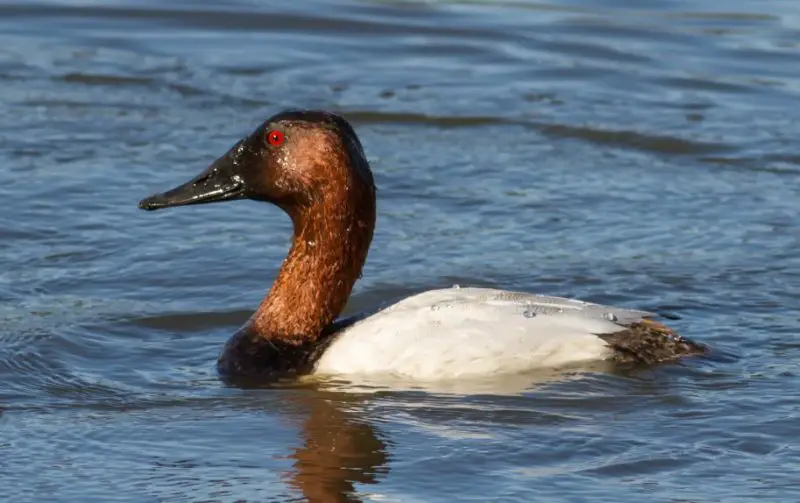
Canvasbacks are large diving ducks notable for their sloping foreheads and long, slanted bills. Males display a chestnut-red head, black chest, and white body, while females are pale brown with a darker head and chest. Their striking profile and contrasting colors make them easy to identify, especially in flight.
In Arkansas, Canvasbacks are primarily winter visitors, frequenting large lakes, reservoirs, and marshes with deep water. They prefer open water areas where they can dive for aquatic plants and invertebrates. Canvasbacks often form large flocks during migration and winter, especially in the Mississippi Alluvial Valley.
These ducks feed mainly on submerged vegetation such as wild celery, pondweeds, and other aquatic plants. They dive underwater to forage, using their strong legs and webbed feet to reach food on the bottom. Canvasbacks’ feeding habits make them important consumers of aquatic plants in Arkansas’s wetland ecosystems.
Redhead (Aythya americana)
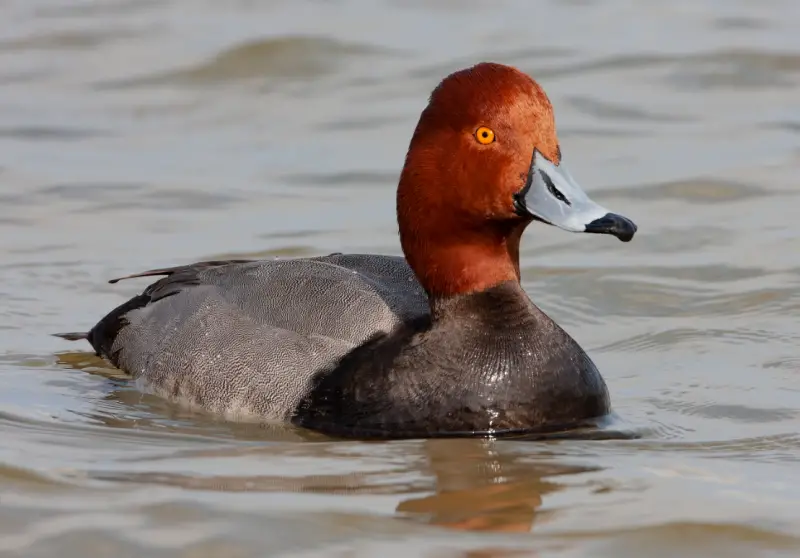
Redheads are medium-sized diving ducks known for their round heads and distinctive coloration. Males have a rusty-red head, black breast, and gray body, while females are mottled brown with a darker crown. Both sexes have bright yellow eyes that stand out against their darker heads.
In Arkansas, Redheads are common winter visitors found in large lakes, ponds, and marshes with ample submerged vegetation. They often share habitat with Canvasbacks and other diving ducks and prefer areas with clear, open water. Their population peaks during migration and winter months.
Redheads dive to feed on aquatic plants, seeds, and invertebrates, especially mollusks and insect larvae. Their diet is similar to that of other diving ducks, and they use their strong diving ability to access food on lake bottoms. This feeding strategy helps maintain healthy aquatic plant communities in Arkansas wetlands.
Bufflehead (Bucephala albeola)
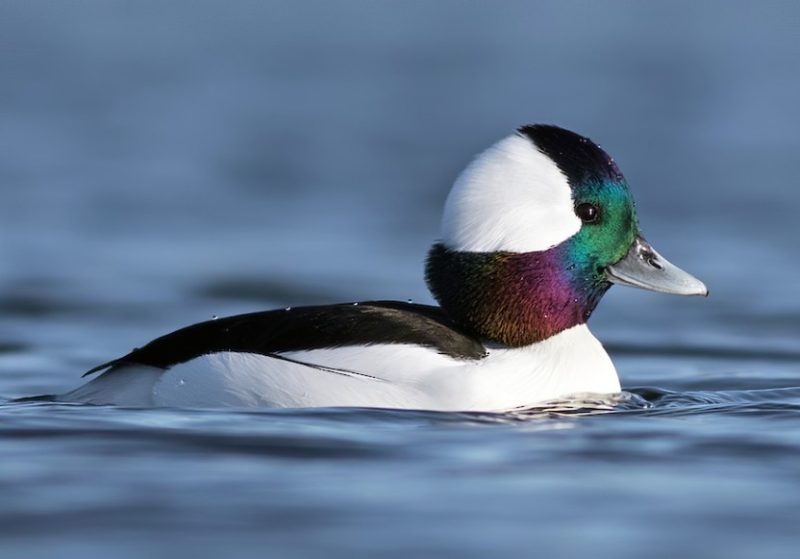
Buffleheads are small, compact diving ducks with distinctive black-and-white plumage. Males have large white patches on their heads, contrasted with iridescent green and purple feathers, while females are mostly gray-brown with a smaller white cheek patch. Their small size and rapid wingbeats make them agile flyers.
In Arkansas, Buffleheads are winter residents found in freshwater lakes, ponds, and rivers, often near wooded shorelines. They prefer clear, open water where they can dive for small aquatic prey. Buffleheads are known for their quick, darting flight and often congregate in small flocks.
These ducks primarily feed on aquatic insects, crustaceans, and mollusks, diving underwater to capture their prey. Buffleheads are especially adept at catching small fish and invertebrates, making them important predators in aquatic ecosystems. Their feeding behavior helps control populations of aquatic insects in Arkansas waters.
Hooded Merganser (Lophodytes cucullatus)

Hooded Mergansers are striking diving ducks easily identified by their fan-shaped, white-and-black crests. Males have a black head with a large white crest, chestnut flanks, and a white chest, while females are brown with a smaller crest and pale throat. Their slender, serrated bills are adapted for catching fish.
In Arkansas, Hooded Mergansers inhabit wooded ponds, swamps, and slow-moving rivers, often near dense vegetation. They nest in tree cavities and are one of the few duck species that prefer forested wetlands. These birds are year-round residents but are more common during migration and winter.
Their diet consists mainly of small fish, aquatic insects, and crustaceans. Hooded Mergansers dive underwater to catch prey, using their sharp bills to grasp slippery fish. Their preference for forested aquatic habitats distinguishes them from many other ducks in Arkansas.
Ruddy Duck (Oxyura jamaicensis)
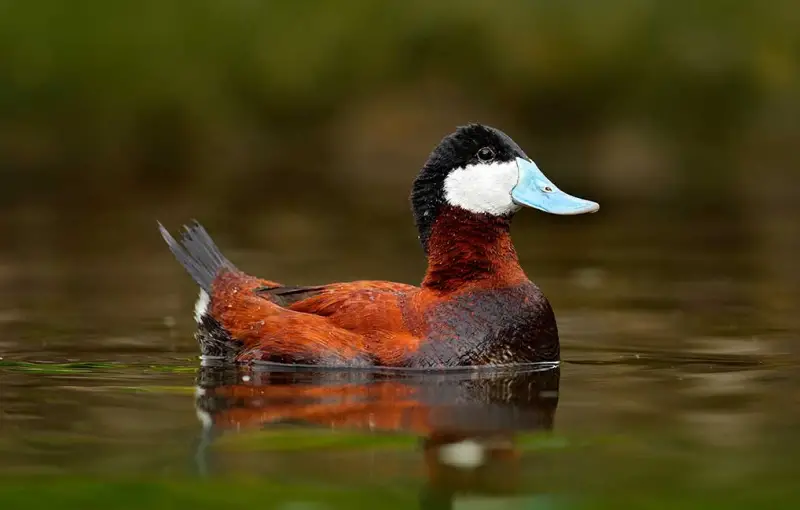
Ruddy Ducks are small, stout diving ducks with distinctive stiff tails that are often held upright. Males in breeding plumage have bright chestnut bodies, sky-blue bills, and white cheeks, while females and non-breeding males are mottled brown with duller bills. Their compact shape and unusual tail posture make them easy to identify.
In Arkansas, Ruddy Ducks are common winter visitors to large lakes, reservoirs, and marshes. They prefer open water with abundant submerged vegetation, where they can dive and forage efficiently. Ruddy Ducks often form tight flocks during the non-breeding season.
Their diet consists mainly of seeds and roots of aquatic plants, along with small invertebrates such as insect larvae and crustaceans. They dive underwater to feed, often stirring up sediment with their feet to uncover hidden food. Their feeding activity plays an important role in the ecology of Arkansas’s aquatic habitats.
Greater Scaup (Aythya marila)
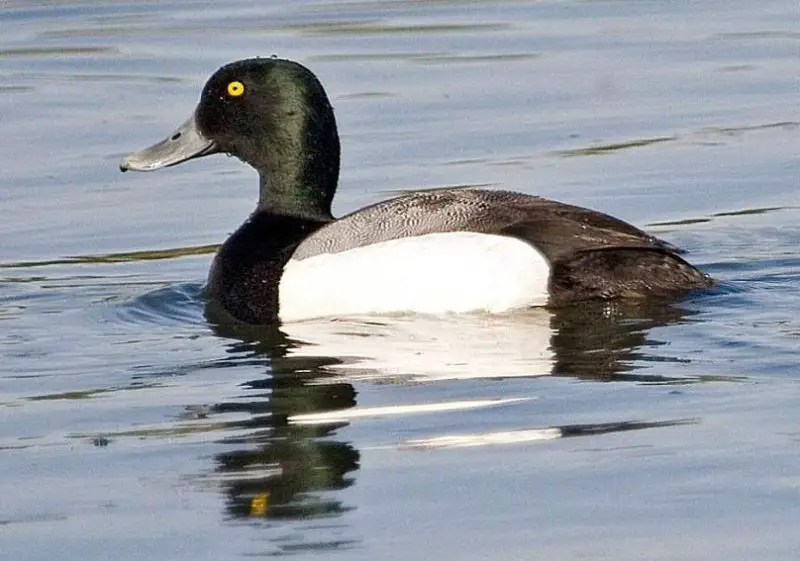
Greater Scaups are medium to large diving ducks characterized by rounded heads and broad bills. Males have a glossy black head with greenish iridescence, a black chest, and white sides, while females are mottled brown with a white patch near the bill base. They are larger and bulkier compared to the similar Lesser Scaup.
In Arkansas, Greater Scaups are primarily winter visitors, frequenting large reservoirs, lakes, and open water bodies. They prefer deep, open waters with abundant submerged vegetation and are often seen in flocks alongside other diving ducks during migration and winter.
Their diet consists mainly of mollusks, aquatic insects, crustaceans, and seeds of submerged plants. Greater Scaups dive underwater to forage, using their strong legs and webbed feet to propel themselves. Their presence helps maintain the balance of aquatic invertebrate populations in Arkansas wetlands.
Black-bellied Whistling-Duck (Dendrocygna autumnalis)
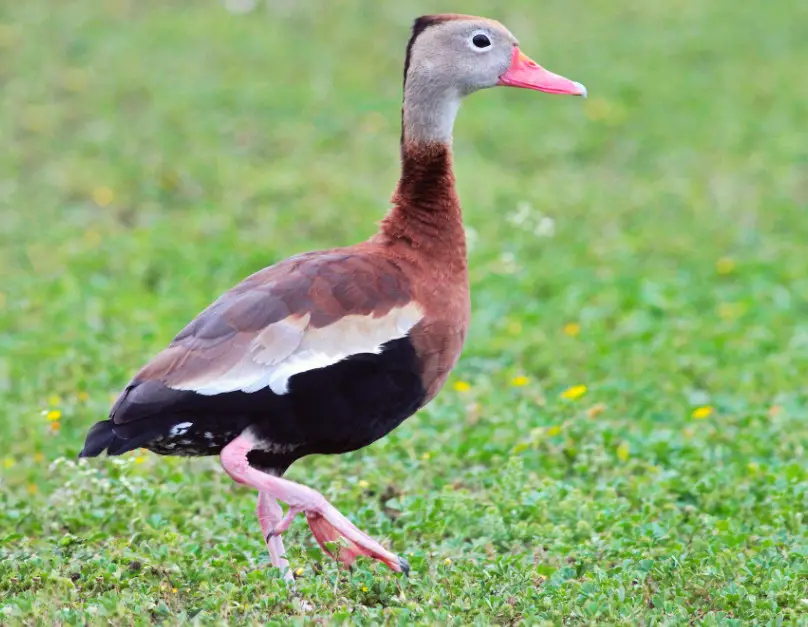
The Black-bellied Whistling-Duck is a medium-sized duck easily recognized by its long neck, pink bill, and distinctive black belly contrasting with chestnut body and grayish back. Its bright red legs and white wing patches are visible in flight, and it is known for its loud, whistling calls.
In Arkansas, this species has been increasing in population and range, often found in freshwater wetlands, ponds, and flooded fields with dense vegetation. They prefer habitats near woodlands or agricultural areas and are sometimes spotted nesting in tree cavities or nest boxes.
Their diet mainly consists of seeds, grains, and aquatic plants, but they also eat insects and small invertebrates. Black-bellied Whistling-Ducks forage on land and in shallow water, often feeding in flocks. Their adaptability to different habitats has contributed to their growing presence in Arkansas.
Mottled Duck (Anas fulvigula)
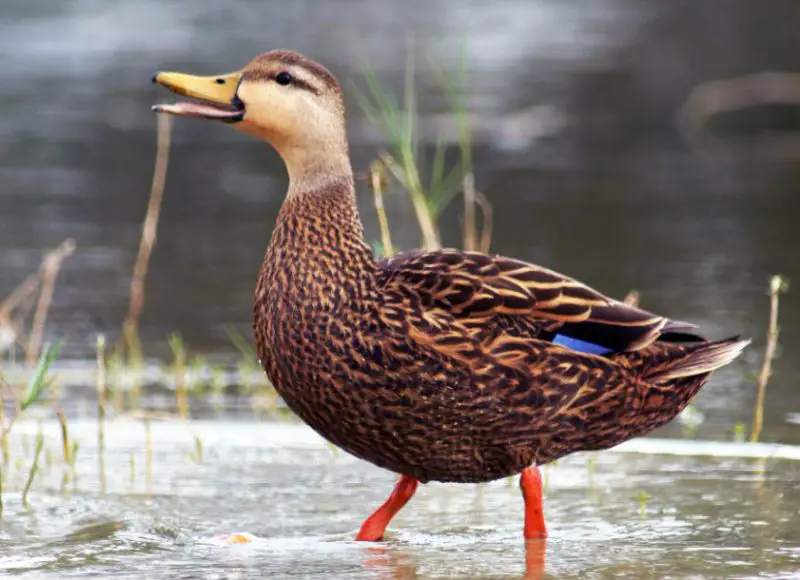
Mottled Ducks are medium-sized dabbling ducks with mottled brown plumage, similar in appearance to female Mallards but with a darker bill and more uniform coloration. Both sexes have orange legs and feet and a slightly darker head with pale stripes near the bill.
In Arkansas, Mottled Ducks are primarily found in coastal marshes and freshwater wetlands in the southern part of the state. They prefer shallow wetlands with dense emergent vegetation and are non-migratory or short-distance migrants within the region.
Their diet consists of seeds, roots, and tubers of aquatic plants, supplemented by small invertebrates. They forage by dabbling and tipping in shallow water and are often seen in pairs or small groups. Mottled Ducks are an important component of Arkansas’s wetland bird diversity.
American Black Duck (Anas rubripes)

American Black Ducks are large dabbling ducks resembling dark Mallards with a rich, dark brown body and slightly lighter head. They have a distinctive pale blue wing patch visible in flight and a yellowish to olive bill. Males and females look similar, with subtle differences in shade.
In Arkansas, American Black Ducks are uncommon but can be found during migration and winter in freshwater wetlands, flooded fields, and river edges. They favor wooded wetlands and often share habitat with Mallards and other dabblers.
Their diet consists of seeds, roots, and aquatic vegetation, along with insects and crustaceans. They forage by dabbling and grazing, often feeding in shallow water or on land. Though less common in Arkansas, American Black Ducks contribute to the region’s waterfowl diversity.
Common Goldeneye (Bucephala clangula)
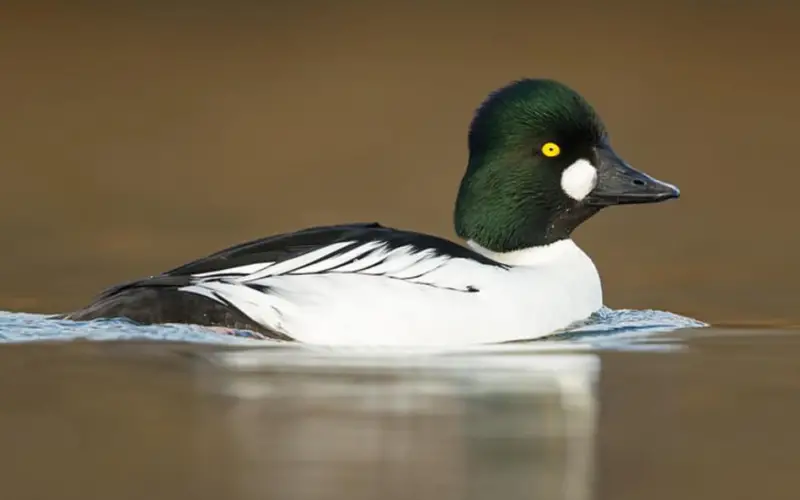
Common Goldeneyes are medium-sized diving ducks noted for their round heads and bright yellow eyes. Males have a dark greenish-black head with a distinctive white circular patch near the bill, white body, and black back. Females are gray with a brown head and smaller white cheek patches.
In Arkansas, Common Goldeneyes are winter visitors found on clear, deep lakes, rivers, and reservoirs. They prefer habitats with clean water and good visibility for diving. These ducks are often solitary or in small groups during the winter season.
Their diet includes aquatic insects, crustaceans, mollusks, and small fish, which they catch by diving underwater. Common Goldeneyes use their sharp bills and agile swimming skills to capture prey, playing an important role in controlling aquatic invertebrate populations in Arkansas’s freshwater systems.
Less Common or Uncommon Ducks (Occasional or Regional)
Cinnamon Teal (Spatula cyanoptera)

Cinnamon Teals are small dabbling ducks known for their striking reddish-brown plumage in males, while females are mottled brown with a lighter face. Males exhibit bright red eyes and a gray bill, making them distinctive among teal species. They have a compact body and a relatively short neck.
In Arkansas, Cinnamon Teals are rare visitors, usually spotted during migration or in winter along shallow wetlands, marshes, and flooded fields. They prefer areas with abundant aquatic vegetation and often share habitat with other teal species like Blue-winged Teals.
Their diet mainly consists of seeds, aquatic plants, and small invertebrates, which they forage by dabbling and tipping in shallow water. Cinnamon Teals feed mostly on plant matter but also consume insects and crustaceans, helping to maintain healthy wetland ecosystems in Arkansas.
Surf Scoter (Melanitta perspicillata)
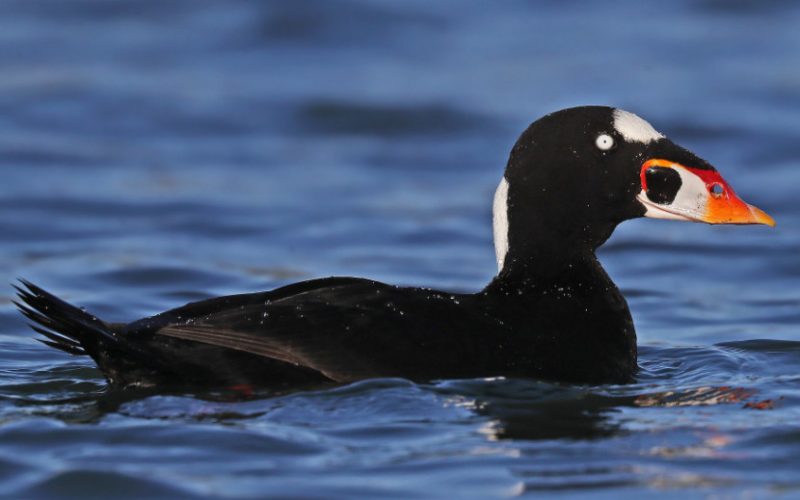
Surf Scoters are large sea ducks recognized by their chunky bodies, large heads, and unique bills marked with colorful patches of orange, white, and black. Males have striking black and white plumage, while females are dark brown with lighter patches on the face and neck.
Though primarily coastal birds, Surf Scoters occasionally appear in Arkansas during migration or winter on large reservoirs and lakes. These ducks prefer deep, open water where they can dive to forage.
Their diet consists mostly of mollusks, crustaceans, and other aquatic invertebrates, which they capture by diving underwater. Surf Scoters’ specialized bills help them crush hard-shelled prey, playing an important role in controlling aquatic invertebrate populations in the state’s larger water bodies.
White-winged Scoter (Melanitta deglandi)

White-winged Scoters are large diving ducks with robust bodies and distinctive white patches on their wings and forehead. Males are mostly black with white wing patches and a striking bill marked with orange and black, while females are brown with similar wing markings.
In Arkansas, White-winged Scoters are rare visitors seen in winter on large lakes and reservoirs. They prefer deep, open water where they can dive for food. These ducks often occur in small flocks and are less common than other scoter species in the region.
Their diet mainly consists of mollusks, crustaceans, and aquatic insects, which they forage underwater by diving. White-winged Scoters’ feeding habits contribute to maintaining the balance of benthic invertebrate populations in Arkansas’s aquatic habitats.
Black Scoter (Melanitta americana)

Black Scoters are large sea ducks characterized by their all-black plumage in males and dark brown in females, with males having a bulbous yellow knob at the base of their bill. They have stout bodies and relatively short necks, adapted for diving.
Occasionally, Black Scoters appear in Arkansas during migration and winter on large reservoirs and deep lakes, although they are considered rare in the area. They prefer open water habitats with good visibility for foraging.
Their diet mainly includes mollusks, crustaceans, and small fish, which they capture by diving underwater. Black Scoters’ ability to feed on hard-shelled prey helps control aquatic invertebrate populations in Arkansas’s deeper water ecosystems.
Long-tailed Duck (Clangula hyemalis)

Long-tailed Ducks are medium-sized sea ducks notable for their long, pointed tail feathers in males and their striking seasonal plumage changes. Males display white heads with dark patches, chestnut necks, and long tail feathers, while females are mostly gray-brown with shorter tails.
In Arkansas, Long-tailed Ducks are rare winter visitors to large lakes and reservoirs. They prefer deep, cold waters where they can dive for food and often form small flocks during the non-breeding season.
Their diet consists mainly of mollusks, crustaceans, and small fish, which they capture by diving. Long-tailed Ducks’ diving ability and preference for hard-shelled prey play an important role in the aquatic food webs of Arkansas’s water bodies.
Common Merganser (Mergus merganser)
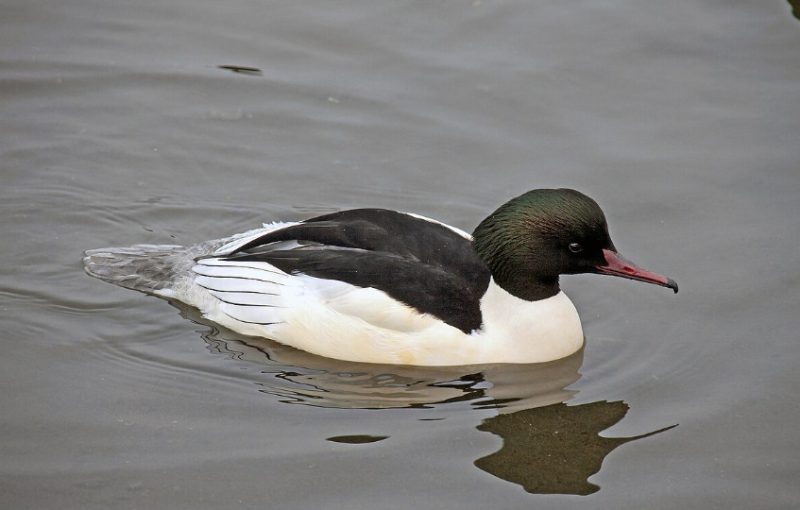
Common Mergansers are large, slender diving ducks with long, thin red bills adapted for catching fish. Males have a dark green head, white body, and black back, while females sport a reddish-brown head with a grayish body. Both sexes have a streamlined shape perfect for diving.
In Arkansas, Common Mergansers are winter visitors frequenting rivers, large lakes, and reservoirs with clear water. They prefer habitats with abundant fish populations, often seen swimming underwater in pursuit of their prey.
Their diet consists mainly of fish, but they also eat aquatic insects and crustaceans. They catch prey by diving and using their serrated bills to grasp slippery fish. This species plays a vital role in controlling fish populations and maintaining aquatic ecosystem balance in Arkansas waters.
Barrow’s Goldeneye (Bucephala islandica)
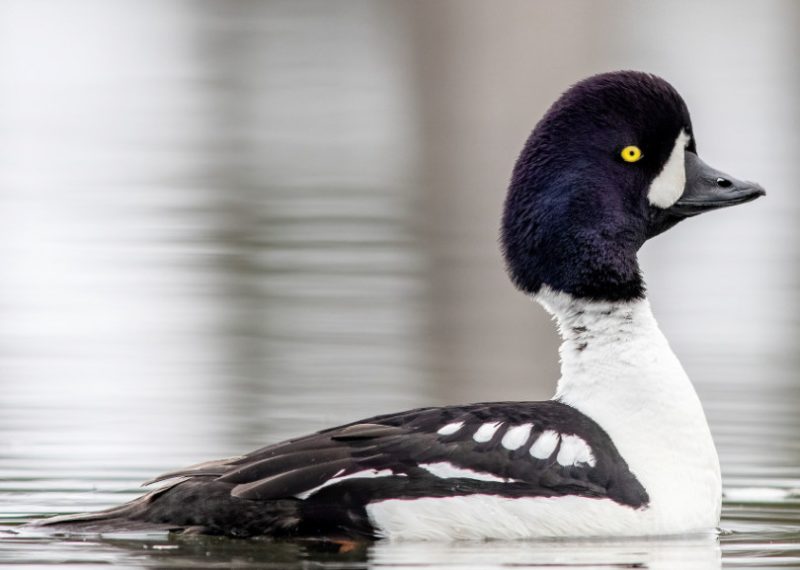
Barrow’s Goldeneyes are medium-sized diving ducks recognizable by their round heads and striking yellow eyes. Males have a black head with a greenish sheen and a distinct white crescent-shaped patch near the bill, a white body, and black back. Females have brown heads with smaller white cheek patches.
These ducks are rare winter visitors in Arkansas, mostly found on clear, deep lakes and rivers. They prefer cold water habitats and are often seen diving for food in small groups.
Their diet consists primarily of aquatic insects, crustaceans, and mollusks, which they capture by diving underwater. Barrow’s Goldeneyes contribute to maintaining healthy aquatic ecosystems by feeding on invertebrates and helping to regulate their populations.
Fulvous Whistling-Duck (Dendrocygna bicolor)
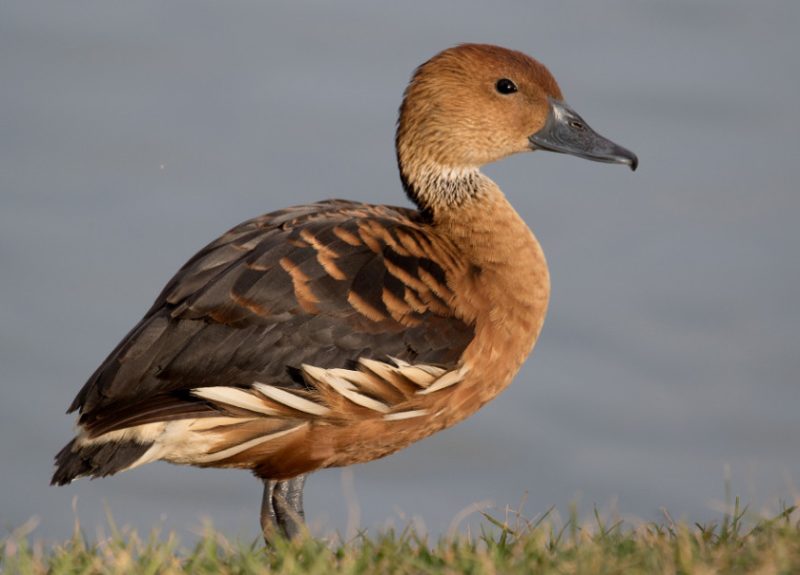
Fulvous Whistling-Ducks are medium-sized waterfowl with long necks and legs, displaying warm, tawny brown plumage all over with darker wings and a pale belly. They have a distinctive whistling call and bright pink legs and bill.
In Arkansas, Fulvous Whistling-Ducks are uncommon but increasing, found mainly in freshwater marshes, ponds, and flooded agricultural fields. They prefer areas with dense emergent vegetation and often roost in trees or tall grasses nearby.
Their diet includes seeds, aquatic plants, and small invertebrates. They forage primarily by dabbling and grazing in shallow water or on land. Fulvous Whistling-Ducks’ adaptability allows them to thrive in a variety of wetland habitats across Arkansas.
Eurasian Wigeon (Mareca penelope)
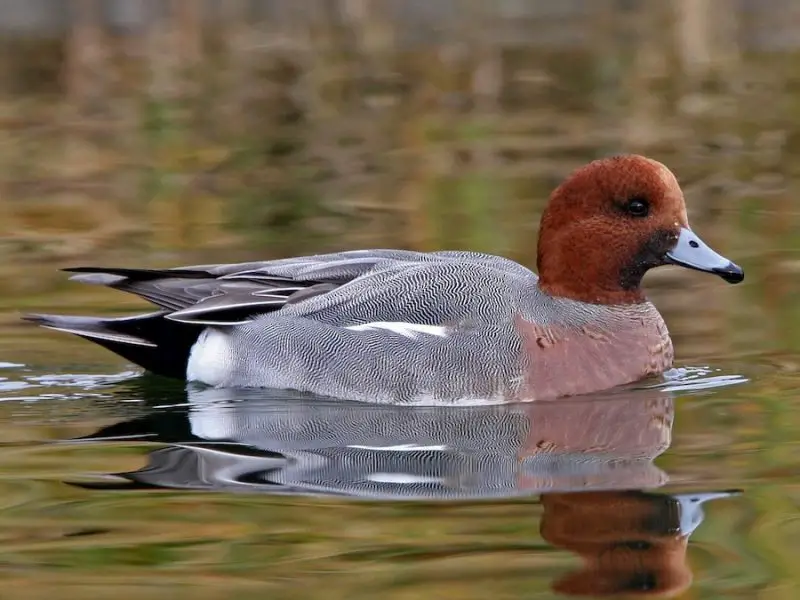
Eurasian Wigeons are medium-sized dabbling ducks closely resembling American Wigeons but with distinct coloration. Males have a reddish-brown body with a cream-colored forehead and crown, while females are mottled brown with more subtle markings.
In Arkansas, Eurasian Wigeons are rare winter visitors, often seen in shallow freshwater wetlands, ponds, and flooded fields. They tend to mingle with flocks of American Wigeons and other dabbling ducks.
Their diet consists mainly of grasses, seeds, and aquatic plants, which they graze on land or dabble for in shallow water. Eurasian Wigeons’ presence adds diversity to Arkansas’s winter waterfowl populations.
Mexican Duck (Anas diazi)

Mexican Ducks resemble Mallards but have more muted and uniform brown plumage with less iridescence in males. They have an olive-green bill and are often darker overall, with males lacking the bright green head typical of Mallards.
In Arkansas, Mexican Ducks are rare visitors found mostly during migration in freshwater wetlands, rivers, and ponds. They prefer habitats with dense aquatic vegetation and calm waters.
Their diet includes seeds, aquatic plants, and small invertebrates, which they forage by dabbling and grazing. Mexican Ducks contribute to the genetic diversity of waterfowl populations in the region and may occasionally hybridize with Mallards.
Rare or Accidental Sightings (Rare Vagrants)
Tufted Duck (Aythya fuligula)
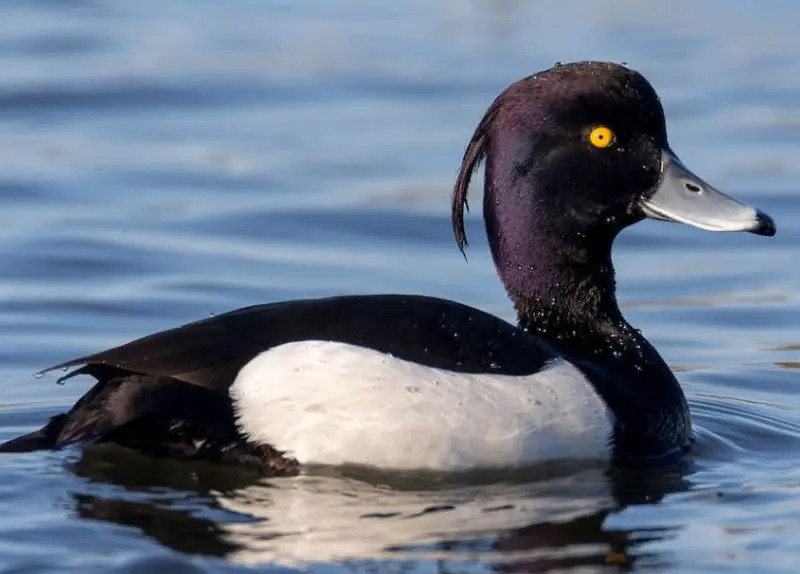
Tufted Ducks are medium-sized diving ducks known for their distinctive tuft of feathers on the back of the male’s head. Males have striking black and white plumage with bright yellow eyes, while females are mostly brown with a smaller tuft and duller eye color. They have compact bodies and short necks, adapted for diving.
In Arkansas, Tufted Ducks are rare visitors, typically seen during migration or winter on large lakes and reservoirs. They prefer open water habitats where they can dive for food and often form small flocks with other diving ducks.
Their diet mainly consists of aquatic insects, mollusks, and small crustaceans, which they forage by diving. Tufted Ducks play a role in maintaining the balance of aquatic invertebrate populations in Arkansas’s freshwater ecosystems.
Garganey (Spatula querquedula)

Garganeys are small dabbling ducks characterized by their slender bodies and distinctive facial markings. Males display a bold white stripe over the eye contrasting with a brown head, while females are mottled brown with a subtler pattern. They have relatively long wings and necks.
In Arkansas, Garganeys are very rare migrants or winter visitors, typically found in shallow wetlands, marshes, and flooded fields. They favor habitats with abundant emergent vegetation for cover and food.
Their diet includes seeds, aquatic plants, and small invertebrates, which they forage by dabbling on the water surface or grazing on land. Garganeys add to the diversity of waterfowl species seen in Arkansas during migration periods.
Masked Duck (Nomonyx dominicus)
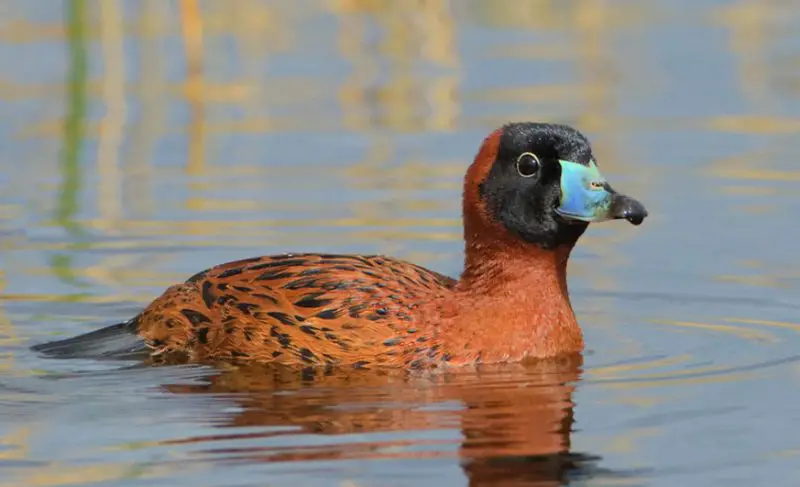
Masked Ducks are small, secretive diving ducks notable for their compact bodies and dark, velvety plumage. Males have a distinctive black mask around the eyes and face, with dark brown bodies, while females are lighter brown with less pronounced facial markings.
In Arkansas, Masked Ducks are rare and elusive, usually inhabiting freshwater marshes, swamps, and densely vegetated ponds. They prefer habitats with dense emergent vegetation, where they can hide and forage safely.
Their diet consists mainly of seeds, roots, and aquatic invertebrates, which they find by diving or dabbling in shallow water. Masked Ducks contribute to the wetland biodiversity in Arkansas and are valued for their unique appearance and behavior.




